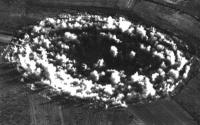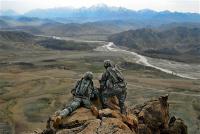-
Forensic seismology tested on 2006 munitions depot explosion in Baghdad

Seismometers were developed to record earthquakes, but then they turned out to be useful for monitoring nuclear tests, and now people are using them in all kinds of creative ways. Seismologists could distinguish, mortars, rockets, improvised explosive devices, helicopters, and drones from four miles away. In 2005 and 2006 ten seismometers were installed in northern and northeastern Iraq to study the seismic properties of the Earth’s crust in that area so that it would be possible to quantify the yield of nearby earthquakes or nuclear tests. They proved useful in identifying conventional explosions as well.
-
-
Pairing seismic data, radionuclide fluid-flow models to detect underground nuclear tests

Underground nuclear weapon testing produces radionuclide gases that may seep to the surface, which is affected by many factors. These include fractures in the rock caused by the explosion’s shock waves that create pathways for the gas to escape plus the effect of changes in atmospheric pressure that affect the gases’ movement. Scientists have developed a new, more thorough method for detecting underground nuclear explosions (UNEs) by coupling two fundamental elements — seismic models with gas-flow models — to create a more complete picture of how an explosion’s evidence (radionuclide gases) seep to the surface.
-
-
Locust-inspired robot traverses rocky terrain, assists in search and rescue

Since the 1980s, advanced robotic platforms have provided assistance to crisis intervention teams in the wake of man-made and natural disasters. The objective of such robots, in various sizes and shapes, has been to intervene where humans cannot and send life-saving data to rescue teams in the field. A new, locust-inspired robot, can jump eleven feet high — more than twice the height of similar-sized robots — and cover a horizontal distance of 4.5 feet in one leap. The researchers believe the robot will perform well in search-and-rescue missions and in reconnaissance operations in rough terrain.
-
-
Russia may be committing war crimes by using banned munitions, targeting civilians: Amnesty

Russian air strikes in Syria have killed hundreds of civilians and caused massive destruction in residential areas, striking homes, a mosque, and a busy market, as well as medical facilities, in a pattern of attacks that show evidence of violations of international humanitarian law, Amnesty International in a new briefing published on Tuesday. Evidence, including photos and video footage, gathered by Amnesty suggests that the Russians have used unguided bombs in densely populated civilian areas, as well as internationally banned deadly cluster munitions. Weapons experts who analyzed images of Russian air attacks said the nature of the destruction caused by the attacks indicated possible use of fuel-air explosives (also known as “vacuum bombs”), a type of weapon particularly prone to indiscriminate effects when used in the vicinity of civilians.
-
-
U.S., Israel to co-develop technologies for first responders

Some $12 million will be funneled to collaborative Israeli-American projects for the development of advanced technologies for first responders over the next three years. The agreement brings together the Israeli Ministry of Public Security and the U.S. Department of Homeland Security in a drive to better equip and prepare both countries’ national rescue forces including fire, police, and first-aid units. Each side will invest equally in the project.
-
-
Better understanding of hybrid warfare needed: Experts

In recent years, armed conflicts have increasingly been fought in a “hybrid” way, in which adversaries rely on a combination of conventional and non-conventional tactics to achieve their military and political objectives. Legal experts say it is essential that the MATO member nations gain a better understanding of the legal challenges posed by new methods of warfare.
-
-
One third of U.K.'s specialized terrorist response vehicles to be scrapped
In 2004, to meet the threat of terrorists using chemical, biological, or nuclear weapons in an attack in the United Kingdom, the government introduced the Incident Response Units (IRUs), with their distinctive red coloring with yellow stripes, at a cost of £54 million. To save money, one third of all the fire brigade vehicles which were part of the IRUs, and which would have been called out in the event of terrorists setting off a “dirty bomb,” are being scrapped.
-
-
Terrorists used encrypted apps to plan, coordinate Paris attacks
The leaders of U.S. and European law enforcement and intelligence agencies have been explicit in their warnings: commercially available communication devices equipped with end-to-end encryption software make it impossible for security services to track terrorists plotting an attack – or monitor the terrorists’ communication while the attack is under way. Sources close to the investigation of the 13 November Paris terrorist attacks have now confirmed that the terrorists used the encrypted WhatsApp and Telegram messengers apps to communicate for a period before the attacks – and with each other during the attacks. What was said in those encrypted messages, and who sent and received these messages, may never be known, because the companies themselves do not have the key – or back door – to decrypt these messages. Thus, security services could not monitor such messages before an attack in order to prevent it, and cannot read these message after an attack to learn more about the terrorists’ network and support system.
-
-
Reducing deadly police force in Rio de Janeiro, and elsewhere
Researchers seek better strategies to control the lethal use of police force in Rio de Janeiro, Brazil. Their findings offer insights for police and communities elsewhere, as the researchers are studying how social and psychological factors affect police and how body-worn cameras can be used most efficiently.
-
-
Examining how law enforcement leaders feel about body cameras
The use of force and police behavior continue to be a prominent topic in the media. Several recent high-profile incidents involving police use of deadly force have resulted in increased scrutiny of officer behavior and police-community relations by the media, policy-makers, civil rights groups, and academics, leading to nationwide interest in police-worn body cameras to increase transparency and accountability. While the use of body-worn cameras on police to address these issues has been endorsed by the media, government, social activists, and policy makers alike, there is scant scientific evidence to support or refute the perceived benefits or drawbacks.
-
-
Improving active shooter response
When an active shooter strikes, every second counts. The sooner law enforcement can respond and the more information they have, the more lives can be saved. Battelle’s SiteGuard Active Shooter Response (ASR) provides a high tech, integrated approach to help protect building occupants in an active shooter event. The ASRcombines gunshot sensors with building security and communication systems to provide critical information to law enforcement and building occupants. As soon as the sensors detect a gunshot, SiteGuard ASR activates a series of predetermined actions and automated responses vital to occupant and first responder safety and optimized response.
-
-
Studying gun violence is the only way to figure out how to stop it – but we don’t
There are about 32,000 gun deaths a year in the United States. There are another 180,000 or so people injured by firearms annually in the country. These numbers far outstrip the consequences of firearms among our peer high-income countries, with stricter gun regulations. One factor that has inhibited the discussions in the public space over gun violence is the relatively limited data we have available about firearms and firearm violence. Gun violence is a public health problem, but it is not studied the same way other public health problems are. The reason: In 1996 the NRA pushed Congress to prohibit the use of funds made available for injury prevention and control at the Centers for Disease Control and Prevention to be used to advocate or promote gun control. The CDC broadly interpreted this as a bar on firearms research, with other federal funders following suit. This has had a chilling effect on gun research. Because of the bar on research, our understanding of the real consequences of the firearm epidemic is surface deep. The United States has had enormous success in responding to other challenges to public health, including, for example, motor vehicle safety, through gathering data that understands the challenge and implementing structural changes to mitigate the potential harm. On the issue of firearm violence, we are not even at the first step.
-
-
FDA clears military traumatic wound dressing for use in civilian population
Early control of severe bleeding may prevent shock and may be life-saving., as 30 to 40 percent of civilian deaths by traumatic injury are the result of hemorrhaging. Of those deaths, 33 to 56 percent occur before the patient reaches a hospital. Last week the FDA cleared the use of the XSTAT 30 wound dressing, an expandable, multi-sponge dressing used to control severe, life-threatening bleeding from wounds in areas that a tourniquet cannot be placed (such as the groin or armpit) in battlefield and civilian trauma settings.
-
-
FBI unable to break 109 encrypted messages Texas terror attack suspect sent ahead of attack

FBI director James Comey told lawmakers this week that one of the suspects in the foiled terror attack in Garland, Texas, in May had exchanged 109 messages with sources in a “terrorist location” overseas ahead of the attack. U.S. intelligence and law enforcement agencies, however, have not been able to break into and read those messages because they were exchanged on devices equipped with end-to-end encryption software which, security services in the United States and Europe argue, make it impossible to monitor and track terrorists and criminals.
-
-
Assad’s future; Israel’s missile defense; U.S. overseas bases

Israel’s chief-of staff said that the likelihood of the Assad-Hezbollah-Iran axis winning the war in Syria is “zero” (his words). The Alawite community is too small to continue and provide soldiers to Syria’s army; both Iran and Hezbollah appear to have concluded that the cost of maintaining Assad in power is just too high; and Russia has decided against sending ground troops. Israel has successfully tested the Arrow-3, its anti-ballistic system designed to intercept long-range missiles. The Pentagon proposes creating an architecture of hub-and-spokes military bases overseas to fight terrorists.
-
More headlines
The long view
Factories First: Winning the Drone War Before It Starts
Wars are won by factories before they are won on the battlefield,Martin C. Feldmann writes, noting that the United States lacks the manufacturing depth for the coming drone age. Rectifying this situation “will take far more than procurement tweaks,” Feldmann writes. “It demands a national-level, wartime-scale industrial mobilization.”
How Male Grievance Fuels Radicalization and Extremist Violence
Social extremism is evolving in reach and form. While traditional racial supremacy ideologies remain, contemporary movements are now often fueled by something more personal and emotionally resonant: male grievance.
The Surprising Reasons Floods and Other Disasters Are Deadlier at Night
It’s not just that it’s dark and people are asleep. Urban sprawl, confirmation bias, and other factors can play a role.
Why Flash Flood Warnings Will Continue to Go Unheeded
Experts say local education and community support are key to conveying risk.
